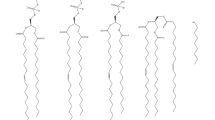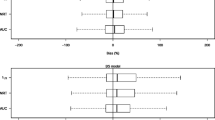Abstract
In many pharmacodynamic investigations venous drug concentrations are measured and linked to effect-site concentrations by means of a traditional first-order effect-compartment model to estimate pharmacodynamic (PD) parameters. This analysis ignores the underlying physiology that arterial blood supplies both the venous sampling site and effect site. Recently, an extended effect-compartment model has been proposed that reflects physiology by postulating a first-order rate constant of equilibrium between arterial and effect-site concentrations (ke0 ) as well as a first-order rate constant between arterial and venous concentrations (kv0 ). In the current paper, we evaluate the bias in PD parameter estimates if venous drug concentrations are measured and linked to effect-site concentrations by a traditional effect compartment as a function ke0 , kv0 , and the drug's elimination half-life (T1/2 ); we present an analytical solution to the differential equations characterizing the extended effect-compartment model; and we evaluate the performance of the extended effect-compartment model to estimate pharmacodynamic parameters on the basis of venous drug concentrations. Time profiles of venous drug concentrations and drug effect were simulated for a wide range of different values of the half-life of ke0 (T1/2,e0 ), the half-life of kv0 (T1/2,v0 ), and T1/2 . The simulations showed that a significant bias (up to 90%) in PD parameter estimates occurred for certain values of T1/2,e0 , T1/2,v0 , and T1/2 if venous drug concentrations are linked to effect-site concentrations by a traditional effect-compartment model. This model misspecification is not apparent from the results of the fitting procedure. The extended effect-compartment model provided unbiased but imprecise PD parameter estimates. The extended effect-compartment model was also able to analyze instances in which the venous concentrations equilibrate slower with the arterial concentrations than the effect-site concentrations, and proteresis is observed in the concentration–effect relationship. It is concluded that if the apparent T1/2 of the drug in the time period in which the decline in pharmacological effect is most pronounced is greater than 5 times T1/2,e0 and T1/2,e0 is greater than T1/2,v0 there is no need to model the underlying arteriovenous equilibrium delay. Under these conditions a traditional first-order link between venous and effect-site concentrations will yield accurate and reliable (less than 10% bias) estimates of the PD parameters such as Emax , EC50 , and N. If T1/2 is less than 5 times T1/2,e0 or if T1/2,v0 is greater than T1/2,e0 , the underlying arteriovenous equilibration delay needs to be taken into account in the model to obtain unbiased estimates of the PD parameters. This applies for almost all values of T1/2,v0 . Arteriovenous equilibration delay can be best taken into account by measuring arterial blood concentrations. If this is not possible, the extended effect-compartment link model can be used. However, a large number of effect measurements needs to be obtained to estimate the model parameters accurately.
Similar content being viewed by others
REFERENCES
G. Serge. Kinetics of interaction between drugs and biological systems. J. II Farmaco 23:907–918 (1968).
L. B. Sheiner, D. R. Stanski, S. Voseh, R. D. Miller, and J. Ham. Simultaneous modelling of pharmacokinetics and pharmacodynamics: application to d-tubocurarine. Clin. Pharmacol. Ther. 25:358–371 (1979).
D. Verotta and L. B. Sheiner. Simultaneous modelling of pharmacokinetics and pharmacodynamics: an improved algorithm. CALBIOS 3:345–349 (1988).
E. Fuseau and L. B. Sheiner. Simultaneous modelling of pharmacokinetics and pharmacodynamics with a non-parametric pharmacodynamic model. Clin. Pharmacol. Ther. 35:733–741 (1984).
P. Veng-Pedersen, J. W. Mandema, and M. Danhof. A system approach to pharmacodynamics III: an algorithm and computer program COLAPS for pharmacodynamic modelling. J. Pharm. Sci. 80:488–495 (1991).
W. L. Chiou, G. Lam, M. L. Chen, and M. G. Lee. Arterial-venous plasma concentration differences of six drugs in the dog and rabbit after intravenous administration. Res. Commun. Chem. Pathol. Pharmacol. 32:27–39 (1981).
M. Gumbleton, S. Øie, and D. Verotta. Pharmacokinetic-pharmacodynamic modelling in non-steady-state studies and arteriovenous concentration differences. Br. J. Clin. Pharmacol. 38:389–400 (1994).
J. R. Jacobs and P. Nath. Compartmental model to describe peripheral arterial-venous drug concentration gradients with drug elimination from the venous sampling compartment. J. Pharm. Sci. 84:370–375 (1995).
L. B. Sheiner. Clinical pharmacology and the choice between theory and empiricism. Clin. Pharmacol. Ther. 46:605–615 (1989).
W. L. Chiou. The phenomenon and rationale of marked dependence of drug concentration on blood sampling site: implications in pharmacokinetics, pharmacodynamics, toxicology and therapeutics. Clin. Pharmacokin. 17:175–199 (part I); 275–290 (part II), (1989).
H. C. Porchet, N. L. Benowitz, L. B. Sheiner, and J. R. Copeland. Apparent tolerance to the acute effect of nicotine results in part from distribution kinetics. J. Clin. Invest. 80:1466–1471 (1987).
D. Verotta, S. L. Beal, and L. B. Sheiner. Semiparametric approach to pharmacokinetic-pharmacodynamic data. Am. J. Physiol. 256:R1005–R1010 (1989).
D. J. Greenblatt, J. S. Harmatz, T. A. Gouthro, J. Locke and R. I. Shader. Distinguishing a benzodiazepine agonist (triazolam) from nonagonist anxiolytic (buspirone) by electroencephalography: kinetic-dynamic studies. Clin. Pharmacol. Ther. 56:100–111 (1994).
J. Shi, N. L. Benowitz, C. P. Denaro, and L. B. Sheiner. Pharmacokinetic-pharmacodynamic modeling of caffeine: Tolerance to pressor effects. Clin. Pharmacol. Ther. 53:6–14 (1993).
J. W. Mandema, B. Tuk, A. L. van Steveninck, D. D. Breimer, A. F. Cohen, and M. Danhof. Pharmacokinetic-pharmacodynamic modelling of the CNS effects of midazolam and its main metabolite alpha-OH-midazolam in healthy volunteers. Clin. Pharmacol. Ther. 51:715–28 (1992).
J. B. Schwarz, D. Verotta, and L. B. Sheiner. Pharmacodynamic modeling of verapamil effects under steady-state and nonsteady-state conditions. J. Pharmacol. Exp. Ther. 251:1032–1038 (1989).
R. J. Wills, H. E. Gallo-Torres, R. Bertko and B. H. Min. Pharmacokinetics and antisecretory activity of trimoprostil in Heidenhain-Pouch dogs. J. Pharmacol. Exp. Ther. 241:433–437 (1987).
M. Yasuhara, Y. Hashimoto, K. Okumura, R. Hori, T. Sakurai, and C. Kawai. Kinetics of Ajmaline disposition and pharmacological response in beagle dogs. J. Pharmacokin. Biopharm. 15:39–55 (1987).
D. R. Stanski, R. J. Hudson, T. D. Homer, L. J. Saidman, and E. Meathe. Pharmacodynamic modeling of thiopental anesthesia. J. Pharmacokin. Biopharm. 12:223–240 (1984).
C. W. N. Chiang and G. Barnett. Marijuana effect and delta-9-tetrahydrocannabinol plasma level. Clin. Pharmacol. Ther. 36:234–238 (1984).
J. Dow, B. Laquais, J. Tisne-Versailles, B. Pourrias, and M. S. Benedetti. Pharmacokinetics and pharmacodynamics of the antiarrhythmic compound MD750819 in dogs with experimentally induced arrhythmias. J. Pharmacokin. Biopharm. 10:283–296 (1982).
W. L. Chiou and G. Lam. The significance of the arterial-venous plasma concentration difference in clearance studies. Int. J. Clin. Pharmacol. Ther. Toxicol. 20:197–203 (1982).
A. L. Pauca and A. M. Hopkins. Acute effects of halothane, nitrous oxide and thiopentone on the upper limb blood flow. Br. J. Anaesth. 43:326–333 (1971).
S. Bjorkman, D. R. Stanski, D. Verotta, and H. Harashima. Comparative tissue concentration profiles of fentanyl and alfentanil in humans predicted from tissue/blood partition data obtained in rats. Anesthesiology 72: 865–873 (1990).
P. O. Maitre, M. Buhrer, S. L. Shafer, and D. R. Stanski. Estimating the rate of thiopental blood-brain equilibration using pseudo state serum concentrations. J. Pharmacokin. Biopharm. 18:175–187 (1990).
D. Verotta, S. L. Beal, and L. B. Sheiner. Semiparametric approach to pharmacokinetic-pharmacodynamic data. Am. J. Physiol. 256:R1005–R1010 (1989).
M. Buhrer, P. O. Maitre, C. Crevoisier, O. Hung, and D. R. Stanski. Comparative pharmacokinetics of midazolam and diazepam. Anesthesiology 69:A642 (1988).
J. D. Unadkat, L. B. Sheiner, P. J. Hennis, R. Cronnelly, R. D. Miller, and M. Sharma. An integrated model for the interaction of muscle relaxants with their antagonists. J. Appl. Physiol. 61:1593–1598 (1986).
Author information
Authors and Affiliations
Rights and permissions
About this article
Cite this article
Tuk, B., Danhof, M. & Mandema, J.W. The Impact of Arteriovenous Concentration Differences on Pharmacodynamic Parameter Estimates. J Pharmacokinet Pharmacodyn 25, 39–62 (1997). https://doi.org/10.1023/A:1025767710234
Published:
Issue Date:
DOI: https://doi.org/10.1023/A:1025767710234




